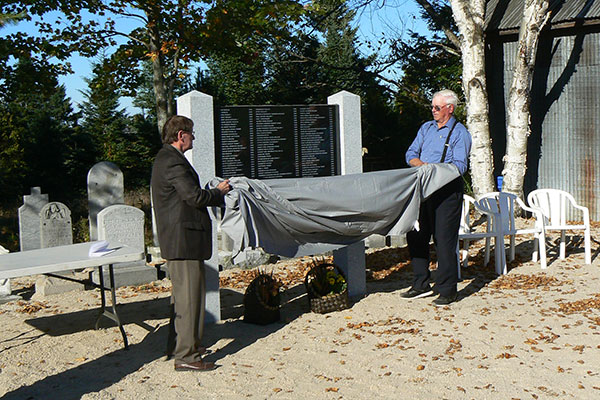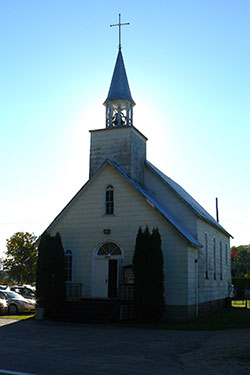A Church Anniversary and an Island of Graves

Bowman Mayor Michel David (right) and St. Paul’s church member Stanley Cheslock unveil a monument honouring the 96 people buried on Cemetery Island.
by James Morgan
A liturgy containing prayers and music in German, French, and English, and a great deal of history figured prominently at a special service on September 28 to celebrate the 135th anniversary of St. Paul’s Lutheran Church in Bowman, Quebec, located north of Gatineau. With the surrounding maple-covered mountains showing shades of red and orange, and the temperature unseasonably warm, it seemed like a fitting time to thank God for his faithfulness and to remember the pioneering German settlers who founded this community so unique in Quebec. And while it may sound odd, it was also a moment to reflect on a significant event in the history of electrical development in Quebec—and how it affected this little rural church.
St. Paul’s is a small congregation, now part of the Lutheran Tri-Parish of Western Quebec (along with Our Redeemer, Buckingham and St. Matthew’s, Mulgrave and Derry), served by Rev. Richard Lockstadt. But back in the 1860s, Bowman Township in Papineau County had just opened for settlement. 18 families arrived in the area from Germany, and the Dominion Government sent them to the area near High Falls on the Lièvre River where they established homesteads. The countryside in the area is beautiful, but clearing the land and farming on it would have been a challenge. Small mountains made mostly of Canadian Shield rock covered with forests of pine and maple still dominate the area today. By 1871, the High Falls settlement had a school, store, post office, and notably, St. Paul’s Lutheran Church and adjacent cemetery. One of the early German settlers and church members, Karl Nitschki, served as the first mayor of Bowman Township. The church had 141 members by 1891 and 171 members by 1922. This was all five years before a very dramatic event unfolded.
Cemetery Island
At the same time, events were unfolding in the electricity industry that would greatly affect St. Paul’s Lutheran Church. The James Maclaren Company had entered the burgeoning electricity business, not only to provide power for its own industries and surrounding communities, but also for the nearby province of Ontario, which was dealing with an electricity shortage in the 1920s. The Maclaren-Quebec Power Company (a division of the James Maclaren Company) decided to build a dam at High Falls. Maclaren had reached a lease agreement with the Quebec Minister of Lands and Forests in November 1929 for the High Falls Site and water rights for 22 miles upstream of there. The new hydroelectric dam would produce 115,000 horsepower of electricity. A contract was signed December 20, 1930. The Ontario cabinet had already approved the agreement that August and the Quebec cabinet approved it December 10. The Dominion cabinet approved the agreement in November. The arrangement would give power-thirsty Ontario Hydro 125,000 horsepower of electricity for at least five years.
The High Falls hydroelectric dam had a dramatic affect on St. Paul’s Lutheran Church and the lives of German settlers in the area. The Paisler, Cheslock, Brunke, and Nitschki family properties were among those affected by the dam and the reservoir that expanded the Lievre River and nearby Lac Escalier. These families and others all had to relocate. Most resettled nearby, and their church went with them. The entire St. Paul’s building was relocated, along with the schoolhouse from High Falls. Since 1929, both have been relocated between Poltimore and Bowman.
St. Paul’s Cemetery, however, remained at the original site and became surrounded by the reservoir after the flood. The graves are on what became a new island, later named Cemetery Island. In the late 1980s, the gravestones on Cemetery Island were relocated to the cemetery at the present location of the church. However, 96 people are still buried on the island.
Remembering 135 years

St. Paul’s Lutheran (Bowman, Quebec).
At the 135th anniversary service of St. Paul’s, a monument at the present cemetery was unveiled with those 96 names on it. The Municipality of Bowman and Brookfield Renewable Energy, the power company that now owns the High Falls station contributed to the project. The Mayor and entire council were present for the service and unveiling of the monument.
Rev. Dr. David Somers (Église Luthérienne de l’Ascension, Montreal) was guest preacher for the event. Dr. Somers is an expert authority on the history of Lutheranism in Quebec and also served part of his vicarage at St. Paul’s in the early 1980s. In his sermon, he noted the challenges the congregation has faced for over a century, from the flood and relocation through social and doctrinal differences to today’s issues of a decline in rural population and church attendance. “You’re still here,” he said, but emphasized that “we’re not here to go down memory lane; we’re here to look at the future.”
Dr. Somers referred to the tombstones on the island that were moved to the present-day cemetery and said the most significant tombstone is really the one that was found rolled away on Easter after Christ’s Resurrection. That tombstone had been rolled away after Christ had died and conquered the power of sin and death. In a similar reference to stone, Dr. Somers noted how St. Peter refers to Christ as Lord and foundation of the Church. “We are living stones of the living God,” he added, further stating that tombstones in a cemetery are not a reminder of death, but rather a reminder of what is yet to come.
Many of the people in attendance for the 135th anniversary service at St. Paul’s Lutheran Church are descendants of the early German settlers at High Falls. After the conclusion of the service and dedication ceremony for the monument, parishioners and members of the community enjoyed a meal and fellowship together.
———————
James Morgan is a writer and former broadcaster living in Gatineau, Quebec where he is completing a Ph.D in History at the University of Ottawa. His home congregation is Trinity Lutheran near Gowanstown, Ontario, and he also worships at the Lutheran Tri-Parish of Western Quebec.




